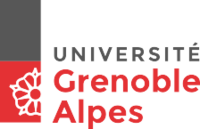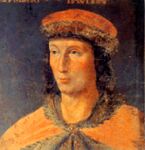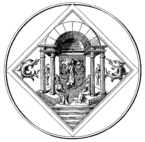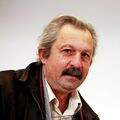Organization:Université Grenoble Alpes
 | |
| Latin: Universitas Gratianopolitana | |
Former name | University of Grenoble (1339–1971) |
|---|---|
| Motto | Veritas Liberabit |
Motto in English | Truth shall set you free |
| Type | Public |
| Established | 1339 |
| Founder | Humbert II of Viennois |
| Budget | €450 million[1] |
| President | Patrick Lévy |
Academic staff | 3,000[1] |
Administrative staff | 2,500[1] |
| Students | 45,000[1] |
| Location | Cities of Grenoble, Saint-Martin-d'Hères & Gières , in France |
| Campus | Urban/College town 432 acres (175 ha)[1] |
| |u}}rs | Red & Gray |
| Affiliations | Aurora, EUA, AUF, SGroup, Community Université Grenoble Alpes |
| Website | www |
The Université Grenoble Alpes (UGA, French: meaning "Grenoble Alps University") is a public research university in Grenoble, France . Founded in 1339, it is the third largest university in France with about 45,000 students and over 3,000 researchers.
Established as the University of Grenoble by Humbert II of Viennois, it split in 1971 following the May 1968 events. Three of the University of Grenoble's inheritors—Joseph Fourier University, Pierre Mendès-France University, and Stendhal University—reunited in 2016 to restore the original institution under the name Université Grenoble Alpes. The university is organized around two closely located urban campuses: Domaine Universitaire of 175 ha which straddles Saint-Martin-d'Hères and Gières, and Campus GIANT of 250 ha in Grenoble. UGA also owns and operates facilities in Valence, Chambéry, Les Houches, Villar-d'Arêne, Mirabel, Échirolles, and La Tronche.[2][1][3]
The city of Grenoble is one of the largest scientific centers in Europe,[4][5] hosting facilities of every existing public research institution in France. This allows UGA to have hundreds of research and teaching partnerships, including close collaboration with the French National Centre for Scientific Research (CNRS) and the French Alternative Energies and Atomic Energy Commission (CEA). Overall, Grenoble as a city is the largest research center in France after Paris with 22,800 researchers.
UGA is traditionally known for its research and education in the natural sciences and engineering, but also law, linguistics, and psychology.[6][7] It has been cited among the best and most innovative universities in Europe.[8][9][10] It is also renowned for its academic research in humanities and political sciences, hosting some of the largest research centers in France in fields such as political science, urban planning or the sociology of organizations.
History
Early history (1339–1800)
The University of Grenoble was founded in May 12, 1339 by Humbert II of Viennois, the last independent ruler of Dauphiné, a state of the Holy Roman Empire. Its purpose was to teach civil and canon law, medicine, and the liberal arts.[11] It was considered a leader in the Renaissance revival of the classics and development of liberal arts.[12]
Humbert's actions were inspired by his granduncle Robert, King of Naples, at whose royal court Humbert spent his youth.[13] King Robert, known as the Wise, skillfully developed Naples from a small port to a lavish city and had a reputation of a cultured man and a generous patron of the arts, friends with such great minds as Petrarch, Boccaccio, and Giotto.[14][13]
Such rich experience contributed to Humbert's intention to create a university in his own state, and to do so he visited Pope Benedict XII to get a papal bull of approval.
Humbert cared deeply about his students, offering generous aid, protection, and even providing a hundred of them with free housing.[15] Humbert's financial losses during the Smyrniote crusades, Black Death, and Dauphiné's attachment to France have greatly decreased the activity of the university leading to its closure, since a small mountainous town couldn't support its activity on its own.[13]
It was reopened again by Louis XI of France in 1475 in Valence under the name University of Valence, while the original university was restored in Grenoble in 1542 by Francis de Bourbon, Count of St. Pol.[16] The two universities were finally reunited in 1565. At that point Grenoble was an important center of law practice in France, thus law practice was at the center of the university education.[17]
The French Revolution , with its focus on the end to inherited privilege, led to the suppression of most universities in France. To revolutionaries, universities embodied bastions of corporatism and established interests. Moreover, lands owned by the universities and utilized for their support represented a source of wealth and therefore were confiscated, just as property possessed by the Church.
Modern period (1800–1968)
In 1805–1808, Napoleon reestablished faculties of law, letters, and science. The Bourbon Restoration had temporarily suppressed the Faculty of Letters and the Faculty of Law, but by the 1850s the university's activity had begun rapidly developing again.[18]
The development of the sciences at the university was spearheaded by the transformation of Grenoble from a regional center to a major supplier of industrial motors and electrical equipment in 1880s.[18] The faculties were formally inaugurated as the University of Grenoble in 1879 in the newly constructed Place de Verdun.[19] There were around 3000 students in 1930. Significant enrollment growth in the 1960s created pressures on the academic infrastructure of the university; the library Suzanne Dobelmann helped expand facilities, especially those relating to science and medicine.[20]
Recent history (1968–present)
Following riots among university students in May 1968,[21] a reform of French education occurred. The Orientation Act (Loi d’Orientation de l’Enseignement Superieur) of 1968 divided the old faculties into smaller subject departments, decreased the power of the Ministry of National Education, and created smaller universities, with strengthened administrations.[22]
Thus, sharing the fate of all French universities in 1970s, the University of Grenoble was split into four institutions. Each university had different areas of concentration of study and the faculties were divided as follows:
- Scientific and Medical University of Grenoble, which in 1987 was renamed Joseph Fourier University (UJF), for sciences, health, and technology
- University of Economics and Law, which in 1987 was renamed Pierre Mendès-France University (UPMF), for social sciences and humanities
- Grenoble Institute of Political Studies, affiliated with UPMF and focusing on political science
- University of Languages and Letters, which in 1987 was renamed Stendhal University, for arts and languages
- Grenoble Institute of Technology (Grenoble-INP) for engineering
On 1 January 2016, the first three institutions reunited to restore the original common institution under the name Université Grenoble Alpes. Although Grenoble-INP remains separate, it is an active member of the Community Université Grenoble Alpes and cooperates very closely with the university not only in research projects, but also by sharing labs, offering mutual courses and training for students and researchers.
Governance
The Université Grenoble Alpes is a public institution of scientific, cultural and professional relevance, which, similar to other universities in France, is governed by a board of directors and an academic council elected every four years. The president of the university is elected by the board of Directors after each renewal, and is eligible for re-election once. On 3 December 2015, staff and students from Joseph Fourier University, Pierre Mendès-France University, and Stendhal University voted to elect representatives to the central councils of the new university. On 7 January 2016, the Board of Directors of the Université Grenoble Alpes elected Lise Dumasy as president. It was the first time a woman has been elected to head a merged university in France.[23]
The university is also a member of the Community Université Grenoble Alpes, a COMUE whose current president is Patrick Lévy. The association allows the humanities and social sciences and natural and formal sciences to be represented in the governance of the entire university system of Grenoble.[24]
Academics
Template:Infobox world university ranking
The Université Grenoble Alpes is made up of 23 departments, schools and institutes.[25]
- Department of Chemistry and Biology (UFR Chemistry and Biology)
- Department of Computer Science, Mathematics and Applied Mathematics (UFR IM2AG)
- Department for the Bachelor's Degree in Sciences and Technologies (DLST)
- Drôme-Ardèche Sciences Department (DSDA)
- Faculty of Medicine
- Faculty of Pharmacy
- Department of Foreign Languages (UFR LE)
- Grenoble Academic Institute of Technology 1 (IUT1)
- Grenoble Academic Institute of Technology 2 (IUT2)
- Faculty of Economics
- Faculty of Law
- Grenoble IAE
- Grenoble Observatory for Sciences of the Universe (OSUG)
- Humanities and Social Sciences Teaching and Research Department (UFR SHS)
- Humanities Teaching and Research Department (UFR ARSH)
- Institute of Urban Planning and Alpine Geography (IUGA)
- Department of Languages, Literature, Performing Arts, Information and Communication (UFR LLASIC)
- Department of Physical and Sports Activities (UFR STAPS)
- Department of Physics, Engineering, Earth and Environmental Sciences and Mechanics (UFR PHITEM)
- School of Engineering (Polytech Grenoble)
- School of Teaching and Education (ESPE)
- University Centre for French Studies (CUEF)
- Valence Academic Institute of Technology (IUT Valence)
In addition, there is Grenoble Institute of Political Studies - an autonomous institute of the Université Grenoble Alpes, focusing on rigorous training of students in political sciences.
Research
Covering all disciplinary fields, the Université Grenoble Alpes has 106 research departments spread out in six centres bringing together different types of organisations (joint research departments, host teams, platforms, etc.) in the same scientific field.[26]
- Humanities and Social Science Centre (Pôle SHS)
- Chemistry, Biology and Health Centre (Pôle CBS)
- Mathematics, Information and Communication Sciences and Technologies Centre (Pôle MSTIC)
- Particle Physics, Astrophysics, Geosciences, the Environment and Ecology Centre (Pôle PAGE)
- Physics, Engineering and Materials Centre (Pôle PEM)
- Social Sciences Centre (Pôle SS)
Notable people
UGA has a considerable number of notable alumni in several different fields, ranging from academics to political leaders, executives, and artists.
Politics
Many European politicians have studied law, economics, and languages in UGA, including: Reinhold Maier; Helene Weber;Walther Schreiber; Michel Destot; Louis Besson;Thierry Repentin; André Vallini; and Geoffrey Acland.
Other political leaders include: Gaétan Barrette, Minister of Health and Social Services of Canada ; Paul Kaba Thieba, Prime Minister of Burkina Faso; Abderrahmane Benkhalfa, Minister of Finance of Algeria; Hazem El Beblawi, Prime Minister of Egypt; Richard E. Hoagland, US Ambassador; Abdoulaye Wade, President of Senegal; Driss Basri, Interior Minister of Morocco; Ahmedou Ould-Abdallah, Ambassador for Mauritania; Şenkal Atasagun, Chief of the National Intelligence Organization of Turkey; Ignas Jonynas, Lithuanian diplomat; Souvanna Phouma, Prime Minister of Laos; Ali Al Shami, Minister of Foreign Affairs of Lebanon; Fathallah Sijilmassi, Moroccan politician and economist; Mohammed al-Dairi Minister of Foreign Affairs of Libya.
UGA alumni also include American journalist Warren D. Leary, French journalists Éric Conan, Olivier Galzi, Françoise Joly, Laurent Mauduit, Philippe Robinet, Caroline Roux, British Joanna Gosling and Safia Shah, and German Jona von Ustinov, who worked for MI5 during the time of the Nazi regime.
Among social activists who attended UGA, one could find Léo-Paul Lauzon, Léa Roback, Austin Mardon, and the former CEO of the Chicago Urban League James Compton.
Park Geun-hye, President of South Korea[27]
Mathematics and sciences
Numerous prominent scientists have studied at the Université Grenoble Alpes since the development of the hydro-power in the region in 1880s. Prominent fields include physics, material sciences, and computer sciences with alumni like Yves Bréchet,[28] member of the French Academy of Sciences; Rajaâ Cherkaoui El Moursli,[29] who worked on the Higgs Boson discovery; Patrick Cousot,[30] French computer scientist; Joseph Sifakis, Turing Award laureate; Claude Boutron,[31] French glaciologist; Jean-Louis Coatrieux,[32] French researcher in medical imaging; Michel Cosnard,[33] French computer scientist; Paul Trendelenburg,[34] German pharmacologist; Yousef Saad,[35] computer scientist; Maurice Nivat, Catherine Ritz,[36] French Antarctic researcher; Eric Goles, Chilean mathematician; Pierre Colmez, French mathematician; René Alphonse Higonnet,[37] French engineer; Marlon Dumas, Honduran computer scientist; Claire Berger,[38] French physicist.
Jean-Jacques Favier, CNES Astronaut[39]
Charles Elachi, Director of the JPL[40]
Joseph Sifakis, Computer scientist[41]
Alim Louis Benabid, Neurosurgeon[42]
References
- ↑ 1.0 1.1 1.2 1.3 1.4 1.5 Alpes, Université Grenoble. "Université". http://www.univ-grenoble-alpes.fr/fr/grandes-missions/universite/.
- ↑ "ComUE - Les chiffres-clés de la Communauté Université Grenoble Alpes". http://www.communaute-univ-grenoble-alpes.fr/fr/presentation/chiffres-cles/.
- ↑ "Oppportunities". http://www.giant-grenoble.org/en/30-000-men-and-women-joining-forces-to-build-a-world-class-campus/.
- ↑ Esposito, Mark (November 2011). "The Grenoble Cluster of Minalogic: France's most competitive pole?". https://www.researchgate.net/publication/237009624.
- ↑ "Virgile Adam, PhD". http://www.virgile-adam.com/grenoble.
- ↑ "ComUE - Université Grenoble Alpes continues to stand out in international rankings". http://www.communaute-univ-grenoble-alpes.fr/en/news/universite-grenoble-alpes-continues-to-stand-out-in-international-rankings-598929.htm.
- ↑ http://www.communaute-univ-grenoble-alpes.fr/medias/fichier/cp-qsranking-mars2014_1412595630344-pdf
- ↑ "Reuters Top 100: The World's Most Innovative Universities - 2016". Reuters. 28 September 2017. https://www.reuters.com/article/amers-reuters-ranking-innovative-univers-idUSL2N1C406D.
- ↑ https://www.usnews.com/education/best-global-universities/europe
- ↑ "Europe's Most Innovative Universities". Reuters. 14 June 2017. https://www.reuters.com/article/us-innovative-stories-europe-idUSKCN0Z00CT.
- ↑ Herbermann, Charles George; Pace, Edward Aloysius; Pallen, Condé Bénoist; Wynne, John Joseph; Shahan, Thomas Joseph (1 January 1913). "The Catholic Encyclopedia: An International Work of Reference on the Constitution, Doctrine, Discipline, and History of the Catholic Church". Encyclopedia Press. https://books.google.com/books?id=r7kTAAAAYAAJ&pg=PA28.
- ↑ "Universities of Grenoble I, II, and III - university, Grenoble, France". https://global.britannica.com/topic/Universities-of-Grenoble-I-II-and-III.
- ↑ 13.0 13.1 13.2 Livre du centenaire de la faculté de droit: discours, études et documents. Typographie et lithographie Allier Frères. 1906. https://archive.org/stream/livreducentenai00grengoog#page/n23/mode/2up.
- ↑ Kelly, Samantha, The New Solomon: Robert of Naples (1309-1343) and Fourteenth-Century Kingship, page 2 Google Books
- ↑ Livre du centenaire de la faculté de droit: discours, études et documents. Typographie et lithographie Allier Frères. 1906. https://archive.org/stream/livreducentenai00grengoog#page/n25/mode/2up.
- ↑ Chisholm, Hugh (1 January 1911). "The Encyclopedia Britannica: A Dictionary of Arts, Sciences, Literature and General Information". Encyclopedia Britannica Company. https://books.google.com/books?id=yf0a3OFlq3sC&pg=PA756.
- ↑ Livre du centenaire de la faculté de droit: discours, études et documents. Typographie et lithographie Allier Frères. 1906. https://archive.org/stream/livreducentenai00grengoog#page/n29/mode/2up.
- ↑ 18.0 18.1 Nye, Mary Jo (1 January 1986). Science in the Provinces: Scientific Communities and Provincial Leadership in France, 1860-1930. University of California Press. ISBN 9780520055612. https://books.google.com/books?id=aBelc0YcDboC&pg=PA81.
- ↑ Alpes, Université Grenoble. "Accueil". http://www.u-grenoble3.fr/1175503255134/0/fiche___article/.
- ↑ Louis, Desgraves, (1994). "Suzanne Kravtchenko-Dobelmann (1905-1993)" (in fr-FR). Bibliothèque de l'École des Chartes 152 (2). https://www.persee.fr/doc/bec_0373-6237_1994_num_152_2_464348.
- ↑ "France". the Guardian. https://www.theguardian.com/world/page/may1968france. Retrieved 21 June 2015.
- ↑ "Projet de loi relatif aux libertés des universités". http://www.senat.fr/rap/l06-372/l06-3722.html. Retrieved 21 June 2015.
- ↑ placegrenet.fr on 12 January 2016, Lise Dumasy élue à la tête de l'université de Grenoble Alpes.
- ↑ Télégrenoble, Émission Si on parlait du 25 janvier 2016.
- ↑ "Departments, schools and institutes". Université Grenoble Alpes. https://www.univ-grenoble-alpes.fr/en/main-missions/about-us/organisation/departments-schools-and-institutes/departments-schools-and-institutes-133548.kjsp.
- ↑ "Departments, schools and institutes". Université Grenoble Alpes. https://www.univ-grenoble-alpes.fr/en/main-missions/about-us/organisation/departments-schools-and-institutes/departments-schools-and-institutes-133548.kjsp.
- ↑ "Who is Park Geun-hye? Everything You Need to Know". http://www.thefamouspeople.com/profiles/park-geun-hye-6895.php.
- ↑ "Biographie". http://www.college-de-france.fr/site/yves-brechet/.
- ↑ "Biographie R. Cherkaoui". Archived from the original on 2015-04-10. https://web.archive.org/web/20150410025815/http://www.um5a.ac.ma/index.php/fr/accueil/102-french/622-biographie-r-cherkaoui.
- ↑ "Patrick Cousot". http://www.di.ens.fr/~cousot/cv/short.shtml.
- ↑ Hoffmann, Ilire Hasani, Robert. "Academy of Europe: CV". http://www.ae-info.org/ae/Member/Boutron_Claude/CV.
- ↑ "LTSI : Laboratoire Traitement du Signal et de l'Image - LTSI". https://www.ltsi.univ-rennes1.fr/?q=node/158.
- ↑ "Michel COSNARD: biographie et actualités sur EducPros". http://www.letudiant.fr/educpros/personnalites/cosnard-michel.html.
- ↑ Lammers, Wim J. E. P.; Lammers-Van Den Berg, Anne Marijke; Morrison, John F. B.; Petroianu, Georg A. (2006). "Translating Trendelenburg; back to the future". Naunyn-Schmiedeberg's Archives of Pharmacology 373 (2): 134–138. doi:10.1007/s00210-006-0051-8. PMID 16557377.
- ↑ http://www-users.cs.umn.edu/~saad/RES.pdf
- ↑ "Equipe Meca Personnel [fr"]. http://www-lgge.obs.ujf-grenoble.fr/axes/rheologie/catritz.html.[yes|permanent dead link|dead link}}]
- ↑ http://www.dmg-lib.org/dmglib/main/biogrViewer_content.jsp?id=24215004&skipSearchBar=1
- ↑ cb299 (19 February 2015). "cb299". https://www.physics.gatech.edu/user/claire-berger.
- ↑ "Payload Specialist Bio: Favier (08/1996)". https://www.jsc.nasa.gov/Bios/PS/favier.html.
- ↑ "Dr. Charles Elachi". 22 October 2015. Archived from the original on 22 October 2015. https://web.archive.org/web/20151022000151/http://www.jpl.nasa.gov/about/bio_elachi.php.
- ↑ "Joseph Sifakis - A.M. Turing Award Winner". http://amturing.acm.org/award_winners/sifakis_1701095.cfm.
- ↑ Williams, Ruth (2010). "Alim-Louis Benabid: Stimulation and serendipity". The Lancet Neurology 9 (12): 1152. doi:10.1016/S1474-4422(10)70291-X. PMID 21087740.
External links
[ ⚑ ] 45°11′22″N 5°46′12″E / 45.18944°N 5.77°E













